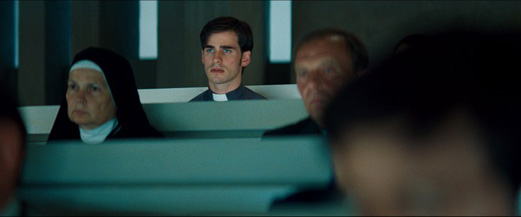|
|
Book vs. Movie: The RiteBy Russ BickerstaffFebruary 2, 2011
Between Baal and a mildly haunting performance by Italian actress Marta Gastini as a demonically possessed pregnant woman, the film compromises the book’s mundane look at the process of exorcism with something a bit more Hollywood. These demons manifest themselves in ways that appear suitably dramatic for the big screen, but without all the head swiveling and projectile vomiting that would make it all seem excessively silly. The biggest departure here seems to be the exorcists’ continual questioning of the demon to attempt to ascertain its name. The theory here is that, if you know the true name of a demon, that gives you power over it. The problem with this as cited in Baglio’s book is that demons do tend to lie — about everything. If a young woman at a bar isn’t going to tell some obnoxious guy her real name, there’s really no reason to believe a demon would reveal its real name to someone who wants to cut short its vacation in Italy. It’s a particularly dramatic moment in the film when a valiantly empowered Kovac demands the name of the demon inhabiting the body of Anthony Hopkins — the one causing hime to act so silly. And rather than come right out and say the name of screenwriter Michael Petroni, Hopkins dramatically expels air in a moan that resonates into the name of Baal. It’s a dramatic moment, but it betrays the duplicitous nature of the demon that seemed so incapable of telling the truth — so ingenious at lying. It’s dramatic, but it sort of weakens the whole film. And so it goes into the closing credits in a very traditional Hollywood trajectory… The Verdict While it’s far from being completely pointless, Matt Baglio’s The Rite lacks the kind of depth and insight that would make it a truly interesting work of journalism. Inspired by the world described in Baglio’s book, the film relates a story that theoretically could’ve been compelling if it bothered to follow some of the book’s finer details just a little bit closer. As it stands, neither film nor book are particularly satisfying. Baglio’s The Rite reads like particularly promising notes for a film that never really ended up getting made. Had those notes been available in their entirety to a screenwriter with a more ingenious design for bringing them to the screen, the film could’ve been a quasi-fictional crystallization of an uneven, uninspired work of nonfiction. There’s no questioning that the subject matter of modern exorcism could have the potential for being interesting on some level, but neither Baglio nor the screenwriter manage to muster enough inspiration to deliver on that potential.
[ View other columns by Russ Bickerstaff ]
[ View other Book vs. Movie columns ]
[ Email this column ]
|

|
|
|

|
Friday, November 1, 2024
© 2024 Box Office Prophets, a division of One Of Us, Inc.


